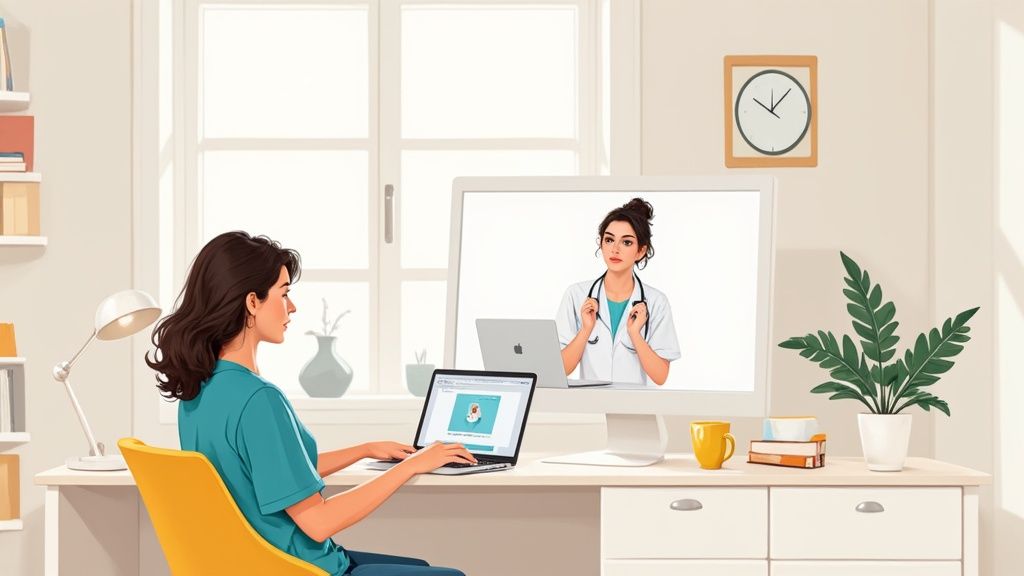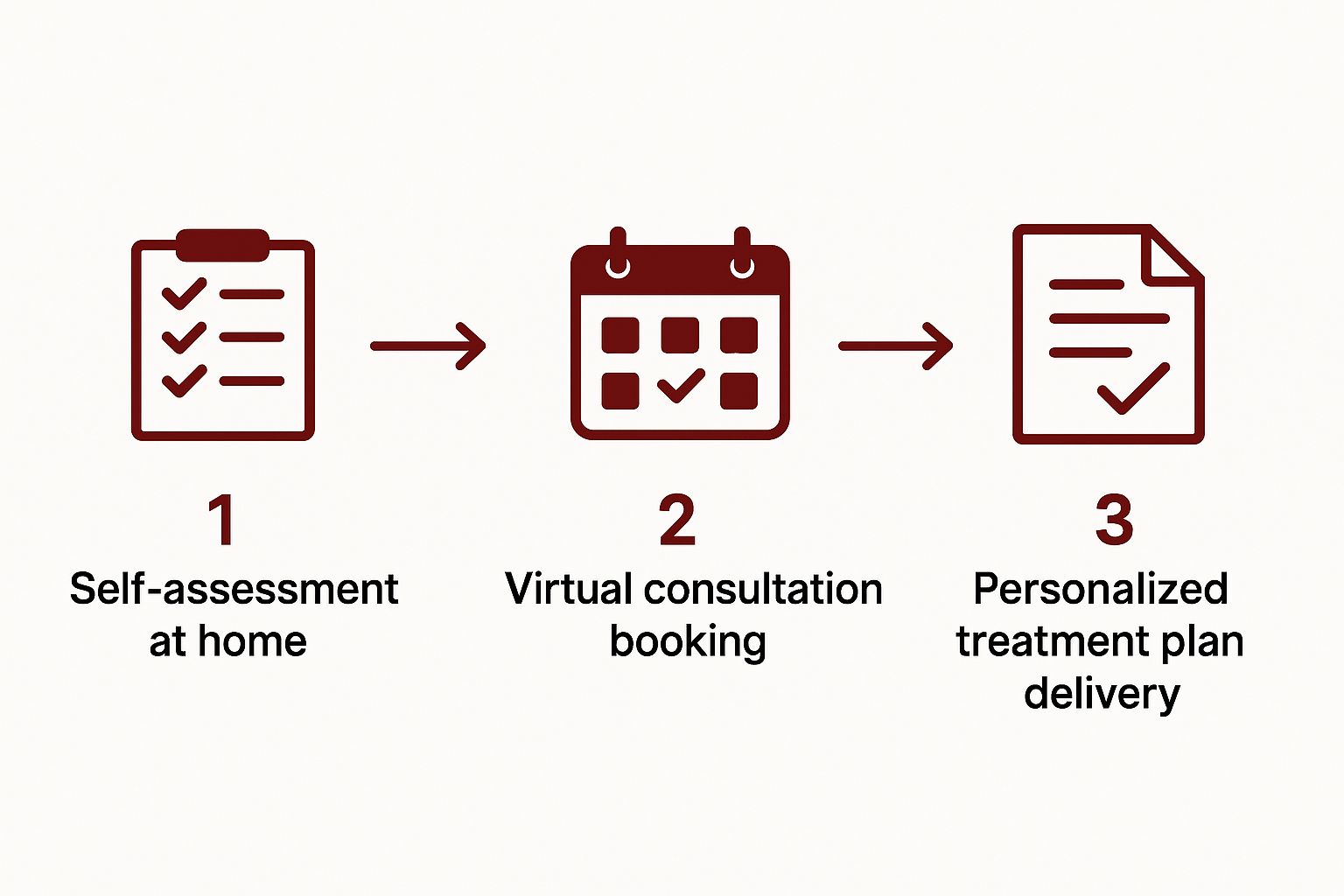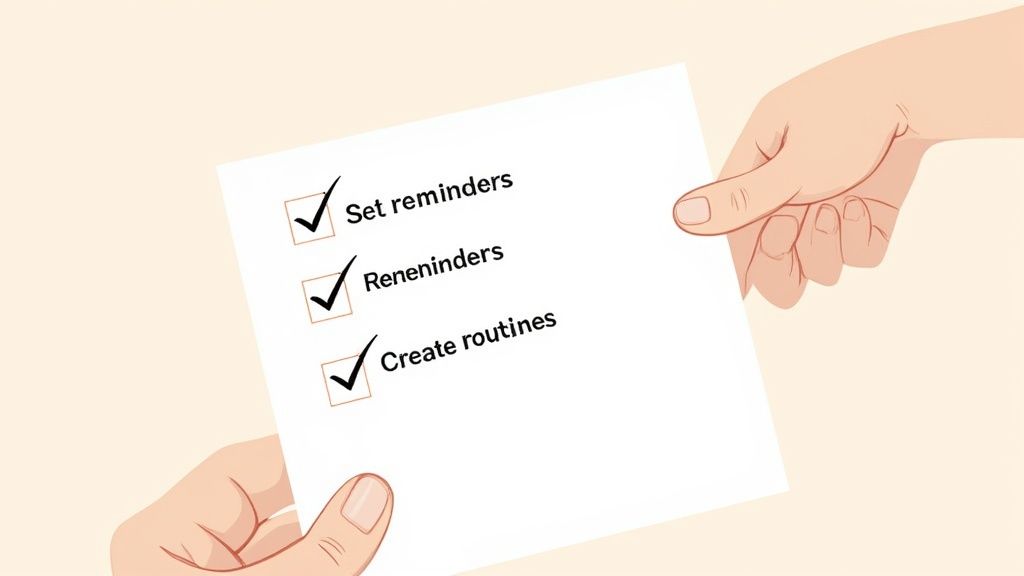The conversation around ADHD is louder than ever, and with it comes a critical need for support that fits our modern lives. This is where online ADHD therapy steps in, offering a vital link to specialized care right from the comfort of your own home, on your own schedule.
The New Era of Accessible ADHD Care

The shift to virtual support for ADHD isn't just about convenience; it’s a fundamental change that makes expert care available to everyone. It knocks down old barriers like distance, demanding work hours, and the anxiety that often comes with walking into a clinical setting.
Think of it as having a dedicated ADHD specialist in your corner, but without all the logistical headaches. This model has become a lifeline for countless adults who have felt stuck, unable to find or travel to a qualified provider. The recent surge in public interest really shows how much this was needed.
The Rise of Virtual ADHD Support
The numbers tell a pretty clear story. Between 2019 and 2023, online searches for "ADHD" shot up by a 270.5% average increase across 19 countries. This digital curiosity is matched by real-world action, as telehealth visits for behavioral health grew from 41% in early 2020 to 67% by the third quarter of 2023. You can read more about the latest ADHD data and trends to see just how significant this shift has been.
This data points to a collective move toward more accessible mental healthcare. Online ADHD therapy offers a practical solution that fits into people's lives, providing support right where and when it's needed most.
Online therapy bridges the gap between needing help and actually getting it. For many with ADHD, simply removing the hurdles of travel and scheduling makes all the difference in starting and sticking with treatment.
To help paint a clearer picture, here’s a quick comparison of the key differences between virtual and traditional therapy approaches.
Online vs Traditional ADHD Therapy at a Glance
This table breaks down the fundamental differences to help you see how the two models stack up.
| Feature | Online Therapy | Traditional Therapy |
|---|---|---|
| Accessibility | Available anywhere with an internet connection. | Requires travel to a physical office location. |
| Scheduling | Highly flexible, with evening and weekend options. | Often limited to standard business hours. |
| Comfort | Sessions are conducted in your own familiar environment. | Takes place in a clinical or office setting. |
| Provider Choice | Access to specialists regardless of geography. | Limited to therapists available in your local area. |
Ultimately, both paths can lead to great outcomes. The key is that online therapy has opened up a new, highly effective option for people who previously felt that quality care was out of reach.
How Online ADHD Therapy Actually Works
The idea of starting online ADHD therapy can feel a bit like stepping into the unknown, but the process is surprisingly clear and built to be user-friendly. Think of it as assembling your own personal support team, but from the comfort of your home. It all starts with signing up on a secure, confidential platform—not much different from creating any other online account.
From there, you'll go through a detailed intake process. This usually involves an assessment or a questionnaire designed to get a full picture of your history, symptoms, and what you hope to achieve. This isn't just a generic quiz; it’s a deep dive into your specific challenges, whether they’re with executive function, emotional regulation, or focus. This step ensures the help you get is actually relevant to you.
The Path to Personalized Care
After you've shared your information, you’re thoughtfully matched with a licensed therapist who specializes in adult ADHD. These platforms really focus on finding the right therapeutic fit. The goal is to connect you with a professional who not only has the proper credentials but whose approach also clicks with your personality and needs. Many services, like the Sachs Center, are dedicated to connecting you with specialists who are experts in diagnosing and treating ADHD in adults, even in cases where it's been highly masked.
Your first session is usually a secure video call. There’s no commute, no waiting room—just a simple click that connects you to your therapist from a space where you feel completely comfortable. This setup removes all the usual logistical headaches and creates a supportive, surprisingly personal way to get help.
The infographic below breaks down the simple, three-step journey from that initial self-assessment to receiving a treatment plan tailored just for you.
As you can see, the whole process is designed to move you smoothly from understanding your needs to getting actionable support.
What Happens in Your Sessions
Once you meet your therapist, the real work begins. These sessions are much more than just casual chats; they are structured to create real-world change.
Effective online ADHD therapy is about co-creating a toolbox of strategies. Your therapist acts as a guide, helping you identify the specific thought patterns and behaviors that hold you back and then building new, more effective habits.
Here’s a glimpse of what you can expect from your therapy sessions:
- Goal Setting: You and your therapist will work together to set clear, achievable goals. This might look like improving time management at work, learning to handle emotional impulsivity in your relationships, or finally tackling that pile of paperwork.
- Skills Training: A huge part of online ADHD therapy is learning practical, hands-on skills. Your therapist will introduce you to proven techniques, like Cognitive Behavioral Therapy (CBT), which can help you reframe negative thought patterns and develop better organizational systems.
- Progress Tracking: Therapy isn't a "set it and forget it" thing. You and your therapist will regularly check in on your progress, celebrating the wins and tweaking strategies when something isn’t working. This ongoing feedback loop is key to keeping up momentum and making sure your treatment stays effective.
The Real-World Benefits of Virtual ADHD Support
So, what does choosing online ADHD therapy actually change in your day-to-day life? The benefits go way beyond just being convenient. It’s really about knocking down the walls that have kept specialized, quality care out of reach for so many people.
Think about it. If you live in a small town, the nearest ADHD specialist could be hours away. Virtual therapy makes that distance disappear, giving you a direct line to top-tier providers no matter your zip code. For a busy parent, it means you can have a productive session on your lunch break without having to line up childcare. These are huge, practical wins.
A More Comfortable Therapeutic Space
Beyond just logistics, the environment itself is a game-changer. Being in your own home for a therapy session can dramatically lower the anxiety that many people with ADHD feel in a sterile, clinical office. When you feel safe and comfortable, it’s much easier to open up and be vulnerable—which is where the real progress happens.
Choosing online therapy means you're not just finding a therapist; you're creating a therapeutic experience that truly fits your life, instead of forcing your life to fit around therapy.
This comfort level also makes it much easier to be consistent. When starting a session is as simple as opening your laptop, you're far more likely to stick with it, build momentum, and see real results.
Broader Access to Specialized Care
The digital format also throws the doors wide open on your pool of potential therapists. You’re no longer stuck with the professionals in your immediate area. This is a massive advantage, especially if you’re looking for someone who gets the nuances of ADHD, like how it presents in women or in adults who have become masters of masking their symptoms.
With an estimated 404 million adults worldwide having ADHD (that’s about 4.4% of the population), the need for accessible care is staggering. Telehealth has really stepped up to meet this demand. In fact, around 46% of adults with ADHD have already used virtual services for support. You can read more about the global impact of adult ADHD to see just how much telehealth is changing the game.
This expanded access boils down to a few key benefits:
- Greater Choice of Specialists: You can find a therapist whose expertise is a perfect match for your specific challenges.
- Cultural and Personal Fit: It’s much easier to connect with a provider who understands your unique background and life experiences.
- Seamless Integration: Therapy stops being a major weekly disruption and becomes a manageable part of your routine.
At the end of the day, online ADHD therapy removes the friction, making it easier than ever to get the expert, personalized support you deserve.
Proven Treatment Methods in Online Therapy
Effective online ADHD therapy is so much more than just talking about your problems. It’s an active, hands-on process of learning real-world skills to manage your symptoms and truly improve your life. Think of it as building a personal toolkit of strategies that help you create lasting, positive habits, all with a trained professional guiding you along the way.
The foundation of most successful ADHD treatment plans is Cognitive Behavioral Therapy (CBT). This evidence-based approach is a perfect match for the challenges that come with ADHD. It’s built on a simple yet powerful idea: our thoughts, feelings, and behaviors are all connected. If you can change your unhelpful thought patterns, you can change your actions and how you feel.
For someone with ADHD, this can be a total game-changer. A therapist might use CBT, for instance, to help you finally break the frustrating cycle of procrastination.
Cognitive Behavioral Therapy in Action
Imagine you’re facing a huge, intimidating project at work. The ADHD brain often sees this as one giant, impossible mountain. This can trigger overwhelming thoughts like, "I'll never get this done, so why even start?" That thought leads to feelings of anxiety, which then leads to the behavior of avoiding the task altogether. Sound familiar?
A therapist using CBT would help you dismantle this entire process. They would guide you to:
- Identify the negative thought: The first step is just recognizing "I'll never get this done" as an unhelpful, distorted thought.
- Challenge and reframe it: Next, you'd work on replacing it with something more realistic and less intimidating, like, "This is a big project, but I can break it into smaller steps."
- Develop a new behavior: Finally, you create a concrete, non-scary plan. For example, "I will spend just 15 minutes outlining the introduction today."
This simple process transforms an overwhelming obstacle into a series of small, achievable wins. It cuts down on anxiety and helps you build momentum. It's a practical skill you can start using in every part of your life. Before committing to a full program, it's often helpful to undergo a formal evaluation to pinpoint your specific needs. Learning about the process of an ADHD assessment for adults can provide clarity on what to expect.
Beyond CBT: Other Powerful Methods
While CBT is a core component, a good online ADHD therapy program will layer in other methods to create a truly well-rounded support system. Your therapist essentially becomes your coach, helping you master skills that directly target the executive function deficits common in ADHD.
Online therapy isn't about "fixing" ADHD. It's about giving you the controls. You learn how your brain works and develop the skills to navigate its unique wiring with confidence and purpose.
This skills-based training often includes:
- Time Management and Organization: Learning practical systems for using planners, digital calendars, and task-management apps in a way that actually works for your brain.
- Emotional Regulation: Developing strategies to identify, understand, and manage intense emotions and hit the pause button on impulsivity.
- Mindfulness Practices: Using simple mindfulness techniques to improve focus, quiet the mental clutter, and become more aware of the present moment.
By weaving these methods together, online therapy provides a robust framework for not just coping with ADHD, but truly thriving with it.
How to Find the Right Online ADHD Therapist
With so many platforms now offering online ADHD therapy, just choosing one can feel like another overwhelming task on your to-do list. It’s a classic ADHD catch-22. But finding the right therapist isn't just a box to check—it’s the most critical step for your success.
Let's break down how to make a confident, informed decision.
The absolute first step is to check a therapist's credentials. You’re looking for a licensed professional, like a psychologist, psychiatrist, or a licensed clinical social worker (LCSW). Crucially, they need specific, hands-on experience treating adults with ADHD. Adult ADHD looks and feels very different from childhood ADHD, and your therapist needs to get that.
The Importance of Therapeutic Fit
Credentials and logistics are the starting line, but the "therapeutic fit" is the magic ingredient that makes therapy work. This is that gut feeling of connection, trust, and being genuinely understood by your therapist.
Without it, even the most qualified professional on paper might not be the right person to help you.
The right therapist doesn't just hear your words; they understand the unspoken challenges behind them. This connection is the foundation of effective therapy, turning sessions from a clinical appointment into a collaborative partnership for growth.
Reading reviews can give you a general sense of a provider, but remember that therapy is deeply personal. Use reviews to spot any major red flags, but always trust your own experience during an initial consultation. To learn more about what to look for, you can explore what makes an effective ADHD therapist for adults and the specific qualities that matter.
Your Provider Evaluation Checklist
Once you've confirmed the basics like licensing, it’s time to dig into the practical details. You need to know if the service itself aligns with your lifestyle, needs, and preferences. A good fit goes way beyond a therapist’s resume; it’s about the entire experience.
When comparing different providers, a simple checklist can help you stay organized and make a clear-headed choice. It prevents you from forgetting key questions and allows for a direct, side-by-side comparison.
Provider Evaluation Checklist
| Evaluation Criteria | Provider A | Provider B | Notes |
|---|---|---|---|
| Licensed & Experienced with Adult ADHD? | |||
| Communication Methods (Video, Text, etc.) | |||
| Experience with Co-occurring Conditions? | e.g., anxiety, depression | ||
| Cost & Payment Model (Per-session vs. Subscription) | |||
| Accepts My Insurance? | |||
| Free Consultation Offered? | |||
| My Gut Feeling After Consultation? | How did I feel talking to them? |
This checklist is your tool for cutting through the noise. Use it to ask targeted questions during free consultations and to keep your thoughts in one place.
Ultimately, take your time with this decision. Finding the right online ADHD therapy provider is an investment in yourself and your well-being. By doing your homework upfront, you’re setting the stage for a rewarding and truly life-changing therapeutic journey.
Navigating Social Media Hype and Finding Real Help
If you’ve spent any time on social media lately, you’ve probably noticed the explosion of content about ADHD. This viral awareness has done some amazing things for starting a conversation, but it's also created a minefield of misinformation. It’s easy to get lost in a sea of personal stories and relatable memes, leaving many people wondering: is this a real symptom, or just a common human experience?
Platforms like TikTok have put ADHD in the spotlight like never before. In fact, one study showed that in 2025, the top 100 videos using the #ADHD hashtag had gathered nearly half a billion views. But when researchers took a closer look, they found that only about 50% of the claims in those videos actually lined up with established clinical criteria. That highlights a pretty big gap between viral content and medical fact. You can read more about these findings and the clinician's guide to ADHD online.
This doesn't mean those feelings of recognition aren't valid. Far from it. That "aha!" moment is often the very first step toward getting real help. The key is to take the next step in the right way.
From Self-Recognition to Professional Care
Seeing your own struggles reflected in someone else's video can feel incredibly validating, but it’s no substitute for a professional evaluation. Self-diagnosing based on social media, while a good starting point for self-discovery, can be misleading. Many symptoms we associate with ADHD—like procrastination or trouble focusing—can also be signs of other conditions like anxiety, depression, or even burnout.
A viral video is a signpost, not a destination. Its job is to point you in the right direction—toward a qualified professional who can provide an accurate diagnosis and a clear path forward.
A licensed provider offering online ADHD therapy can help you untangle these overlapping symptoms. They use proven, evidence-based tools and a deep understanding of neurodiversity to give you a clear, accurate picture of what's really going on.
This is the most reliable way to move from wondering if you have ADHD to knowing for sure and getting the support that will actually make a difference. A therapist can confirm a diagnosis, help create a personalized treatment plan, and arm you with strategies that go far beyond the surface-level tips you'll find on social media. They are your best partner in navigating this journey with confidence.
Frequently Asked Questions About Online ADHD Therapy
Jumping into online ADHD therapy can feel like a big step, and it's completely normal to have questions swirling around. To help clear things up and make you feel more confident, we’ve answered some of the most common questions we hear from people before they get started.
Can I Get an Official ADHD Diagnosis Online?
Yes, you absolutely can. Many online practices have licensed psychologists or psychiatrists who are fully qualified to perform comprehensive ADHD evaluations virtually.
These assessments are designed to be just as rigorous as in-person testing. They use the same validated clinical tools and in-depth interviews to make sure you get an accurate, official diagnosis, all from the comfort of your own home.
The whole point of an online evaluation is to give you diagnostic clarity. It confirms whether ADHD is part of your story and provides a clear path forward for treatment, all through a secure and convenient virtual process.
Is Online Therapy as Effective as In-Person Therapy?
For a lot of people, the answer is a big "yes." Study after study has shown that telehealth for mental and behavioral health, including for ADHD, can be just as effective as traditional, in-office care.
What really matters for success are the same core ingredients, whether you're on a video call or in a therapist's office.
Success really boils down to three key things:
- The Right Therapist: Finding a qualified professional with experience in ADHD is the most important piece of the puzzle.
- The Connection You Build: That feeling of being seen, heard, and understood by your therapist is what truly fuels progress.
- Your Own Engagement: The real change happens when you actively participate in your sessions and put the strategies you learn into practice in your daily life.
When these elements click into place, the virtual format can work wonders.
Can I Get Medication Prescribed Online?
This really depends on the specific online service you choose and the regulations in your state. Some online mental health companies have psychiatrists or psychiatric nurse practitioners on staff who can prescribe and manage medications, including stimulants for ADHD.
Other platforms might focus purely on therapy and skills-coaching, without offering medication services.
If getting medication is a priority for you, it's crucial to check what a provider offers before you sign up. Always ask if they have licensed prescribers who are able to practice in your specific state.
It's also helpful to understand the social side of ADHD. Learning more about understanding ADHD stigma can give you valuable context as you navigate treatment, whether it involves medication or not.
How Much Does Online Therapy Cost?
The cost of online ADHD therapy can vary quite a bit. The final price tag is often shaped by the platform’s business model, the therapist's level of experience, the length of your sessions, and even where you live.
Here’s a quick look at the common ways services are priced:
- Subscription Models: You pay a flat monthly or quarterly fee that usually covers a certain number of sessions and the ability to message your therapist.
- Per-Session Fees: This is a pay-as-you-go model where you are billed for each appointment individually.
- Bundled Packages: You might pay a single upfront fee that covers the initial assessment plus a set number of therapy sessions.
The good news is that many online providers now accept insurance, which can dramatically reduce what you pay out-of-pocket. Make sure to call your insurance company and the therapy provider ahead of time to get a clear picture of your coverage.
At Sachs Center, we specialize in providing clear answers and expert support for adults and children with ADHD. If you're ready for diagnostic clarity and a personalized treatment plan, explore our virtual evaluation and therapy options. Book your appointment at https://sachscenter.com today.


